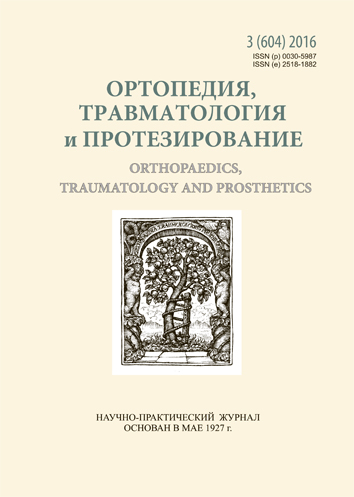Management of orthopedic patients with hypertension in the perioperative period (literature review)
DOI:
https://doi.org/10.15674/0030-598720163110-114Keywords:
surgical intervention, hypertension, antihypertensive drugs, perioperative periodAbstract
Despite significant advances of modern therapies, problem of combination and the simultaneous natural history of various diseases of bones and joints in patients with cardiovascular disorders, remains extremely relevant. Performance of surgical intervention requires anesthesia and hypertension is a known risk factor of adverse outcome in 35 % of patients, it is clear that poorly controlled hypertension remains one of the most common reason for the postponing a scheduled surgeries. Objective: to determine optimal perioperative measures to minimize cardiovascular complications, basing on the analysis of scientific and medical literature. The paper discussing in details the use in the perioperative period different groups of hypotensive drugs (diuretics, inhibitors angiotensin-converting enzyme, sartanas, calcium channel blockers, β-blockers). It is shown that there is sufficient evidence as to the overall cardioprotective effect of general inhalation or intravenous anesthesia. Also ongoing debate about the benefits of neuroaksial methods before general anesthesia and in the ESA/ESC-2014 guidelines provided a reasonable level of evidence (IIb) for advantages of spinal anesthesia and analgesia in reducing the frequency of serious postoperative complications. Authors for improving the safety and effectiveness of surgery in elderly patients with comorbidities emphasize such basic areas for preoperative evaluation methods in patients as risk prediction, identifying factors that increase the risk of surgery and anesthesia, studying hemodynamic status and specifics of anesthesia, study, creation and implementation of best preoperative preparation options, sedation, intraoperative pharmacologically protection and postoperative intensive care, depending on the patient, primary and concomitant pathology, specifics of hypertension and previous drug therapy.References
- Circulation of the blood and anesthesia. Ed. KM Lebedinskii. Saint Petersburg: Chelovek, 2012. 1076 p.
- Malaya LT, Korzh ON, Balkovaya LB. Endothelial dysfunction in the pathology of the cardiovascular system (Endotelialnaya disfunktciya pri patologii serdechno-sosudistoy sistemy). Kharkov: TORSING, 2000. 426 p.
- The order of the Ministry of Health of Ukraine No 384, 24.05.2012: http://www.moz.gov.ua/ua/portal/dn_20120524_384.html.
- Perioperative management of patients with concomitant diseases. Ed. Zabolotskikh IB. Moskow: Prakticheskaya medicina, 2011. 240 p.
- POISE Study Group, Devereaux PJ, Yang H, Yusuf S, Guyatt G, Leslie K, Villar JC, Xavier D, Chrolavicius S, Greenspan L, Pogue J, Pais P, Liu L, Xu S, Málaga G, Avezum A, Chan M, Montori VM, Jacka M, Choi P. Effects of extended-release metoprolol succinate in patients undergoing non-cardiac surgery (POISE trial): a randomised controlled trial Lancet. 2008;371(9627):1839-47. doi: 10.1016/S0140-6736(08)60601-7.
- Galiè N, Humbert M, Vachiery JL, Gibbs S, Lang I, Torbicki A, Simonneau G, Peacock A, Vonk Noordegraaf A, Beghetti M, Ghofrani A, Gomez Sanchez MA, Hansmann G, Klepetko W, Lancellotti P, Matucci M, McDonagh T, Pierard LA, Trindade PT, Zompatori M, Hoeper M. 2015 ESC/ERS Guidelines for the diagnosis and treatment of pulmonary hypertension. Rev Esp Cardiol (Engl Ed). 2016;69(2):177. doi: 10.1016/j.rec.2016.01.002.
- Kristensen SD, Knuuti J, Saraste A, Anker S, Bøtker HE, Hert SD, Ford I, Gonzalez-Juanatey JR, Gorenek B, Heyndrickx GR, Hoeft A, Huber K, Iung B, Kjeldsen KP, Longrois D, Lüscher TF, Pierard L, Pocock S, Price S, Roffi M, Sirnes PA, Sousa-Uva M, Voudris V, Funck-Brentano C; Authors/Task Force Members. 2014 ESC/ESA Guidelines on non-cardiac surgery: cardiovascular assessment and management: The Joint Task Force on non-cardiac surgery: cardiovascular assessment and management of the European Society of Cardiology (ESC) and the European Society of Anaesthesiology (ESA). Eur. Heart J. 2014;35(35):2383-431. doi: 10.1093/eurheartj/ehu282.
- Grant IS, Nimmo GR, Nimmo S, Aitkenhead AR, Smith G, Rowbotham DJ. Intercurrent disease and anaesthesia. Textbook of anaesthesia. Churchill Livingstone, 2007, 444–483.
- Kim CW, Song H, Kumar S, Nam D, Kwon HS, Chang KH, Son DJ, Kang DW, Brodie SA, Weiss D, Vega JD, Alberts-Grill N, Griendling K, Taylor WR, Jo H. Anti-Inflammatory and Antiatherogenic Role of BMP Receptor II in Endothelial Cells. Arterioscler. Thromb. Vasc. Biol. 2013;33(6):1350–1359. doi: 10.1161/ATVBAHA.112.300287.
- Spiekerkoetter E, Tian X, Cai J, Hopper RK, Sudheendra D, Li CG, El-Bizri N, Sawada H, Haghighat R, Chan R, Haghighat L, de Jesus Perez V, Wang L, Reddy S, Zhao M, Bernstein D, Solow-Cordero DE, Beachy PA, Wandless TJ, Ten Dijke P, Rabinovitch M. FK506 activates BMPR2, rescues endothelial dysfunction, and reverses pulmonary hypertension. J Clin. Invest. 2013;123(8):3600–3613. doi: 10.1172/JCI65592.
Downloads
How to Cite
Issue
Section
License
Copyright (c) 2016 Inga Fedotova, Iryna Korzh, Mykola Lyzogub, Oleksandr Barkov, Valentyn Piontkovsky

This work is licensed under a Creative Commons Attribution 4.0 International License.
The authors retain the right of authorship of their manuscript and pass the journal the right of the first publication of this article, which automatically become available from the date of publication under the terms of Creative Commons Attribution License, which allows others to freely distribute the published manuscript with mandatory linking to authors of the original research and the first publication of this one in this journal.
Authors have the right to enter into a separate supplemental agreement on the additional non-exclusive distribution of manuscript in the form in which it was published by the journal (i.e. to put work in electronic storage of an institution or publish as a part of the book) while maintaining the reference to the first publication of the manuscript in this journal.
The editorial policy of the journal allows authors and encourages manuscript accommodation online (i.e. in storage of an institution or on the personal websites) as before submission of the manuscript to the editorial office, and during its editorial processing because it contributes to productive scientific discussion and positively affects the efficiency and dynamics of the published manuscript citation (see The Effect of Open Access).














